My dear readers,The nine goddesses worshipped during Navratri are different forms of Goddess Durga, and each is revered on one of the nine days of the festival. They are collectively known as the Navadurga. Here are their names in order…
Shailaputri – Goddess of the Mountains
Brahmacharini – Goddess of Penance and Devotion
Chandraghanta – Goddess of Courage and Strength
Kushmanda – Goddess of the Cosmic Egg and Creation
Skandamata – Mother of Skanda (Kartikeya)
Katyayani – Warrior Goddess
Kalaratri – Goddess of Destruction of Evil
Mahagauri – Goddess of Purity and Serenity
Siddhidatri – Goddess of Accomplishments and Supernatural Powers
Each day of Navratri celebrates a different form of the goddess with rituals and prayers.
Here’s a brief description of each of the nine goddesses (Navadurga) worshipped during Navratri and How to worship them? Worshipping the nine goddesses of Navratri involves a series of rituals, prayers, and offerings that vary slightly by region and tradition. Below is a basic guide on how to worship the Navadurga during Navratri:
1. Shailaputri (Day 1)

Form: Daughter of the Himalayas.
Symbolism: She represents nature and the root chakra. Shailaputri is the embodiment of Mother Earth and the first form of Durga.
Appearance: She rides a bull (Nandi), holds a trident in one hand and a lotus in the other.Significance: Worshipping her brings stability and strength.
Color: Red
Rituals: Begin with a clean home and altar. Offer red flowers, fruits, and pure ghee in a lamp. Recite Durga mantras or Shailaputri stotram.
Prasad: Pure ghee and sweets made from it.
2. Brahmacharini (Day 2)
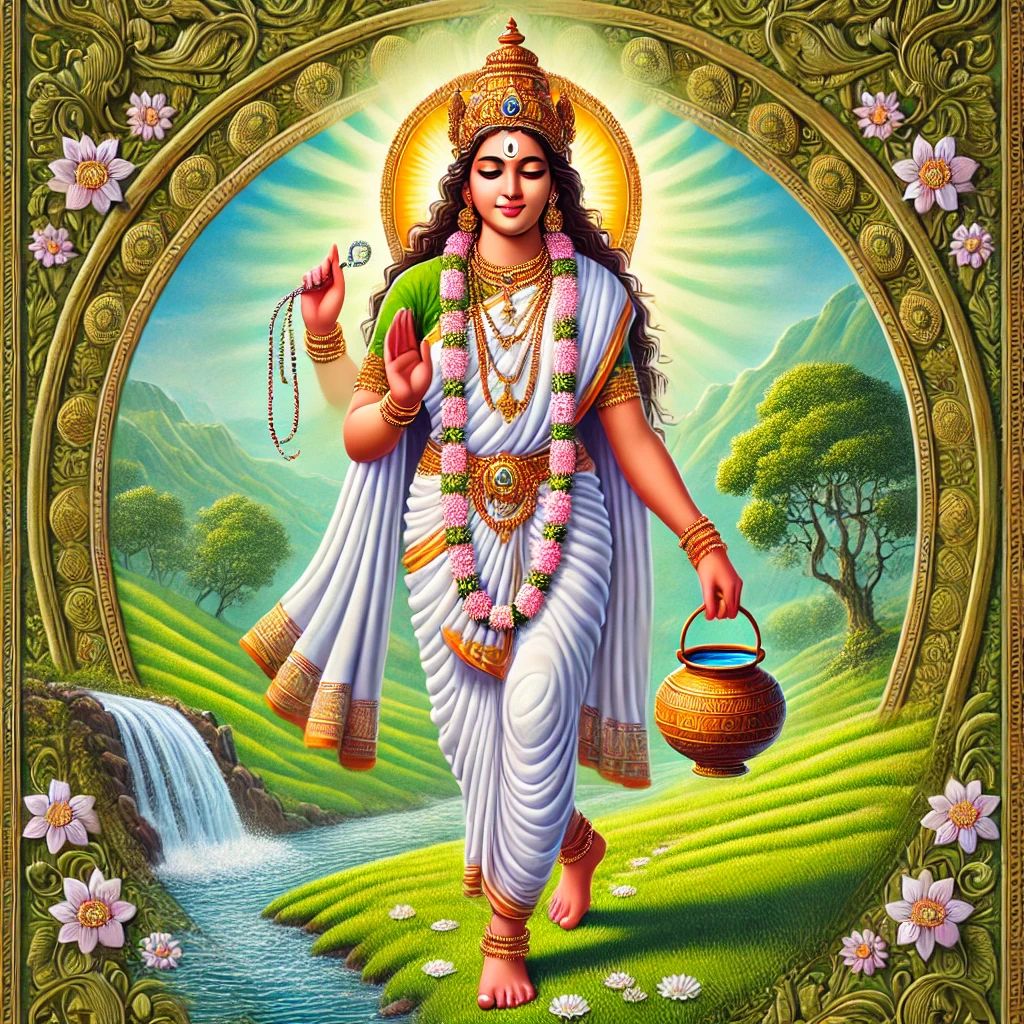
Form: The goddess of penance and devotion.
Symbolism: Represents asceticism, meditation, and self-control. She rules over the Swadhisthana (sacral chakra).
Appearance: She walks barefoot, holding a rosary in her right hand and a kamandalu (water pot) in her left.
Significance: She blesses devotees with wisdom, patience, and spiritual enlightenment.
Color: White
Rituals: Offer white flowers, sugar, or fruits. Light an oil lamp and chant Brahmacharini mantras. Focus on self-discipline and penance.
Prasad: Sugar or fruits like bananas.
3. Chandraghanta (Day 3)

Form: Goddess of peace and courage.
Symbolism: Known for her bravery and strength, she rides a tiger and has a half-moon (Chandra) on her forehead in the shape of a bell (Ghanta).
Appearance: She has ten hands, each carrying weapons. She wears a golden hue and rides a tiger.
Significance: Worshipping her removes all fears and brings peace.
Color: Royal Blue
Rituals: Offer milk-based sweets and yellow flowers. Light an oil or ghee lamp. Chant mantras for Chandraghanta to invoke inner strength and courage.
Prasad: Milk or milk-based products.
4. Kushmanda (Day 4)
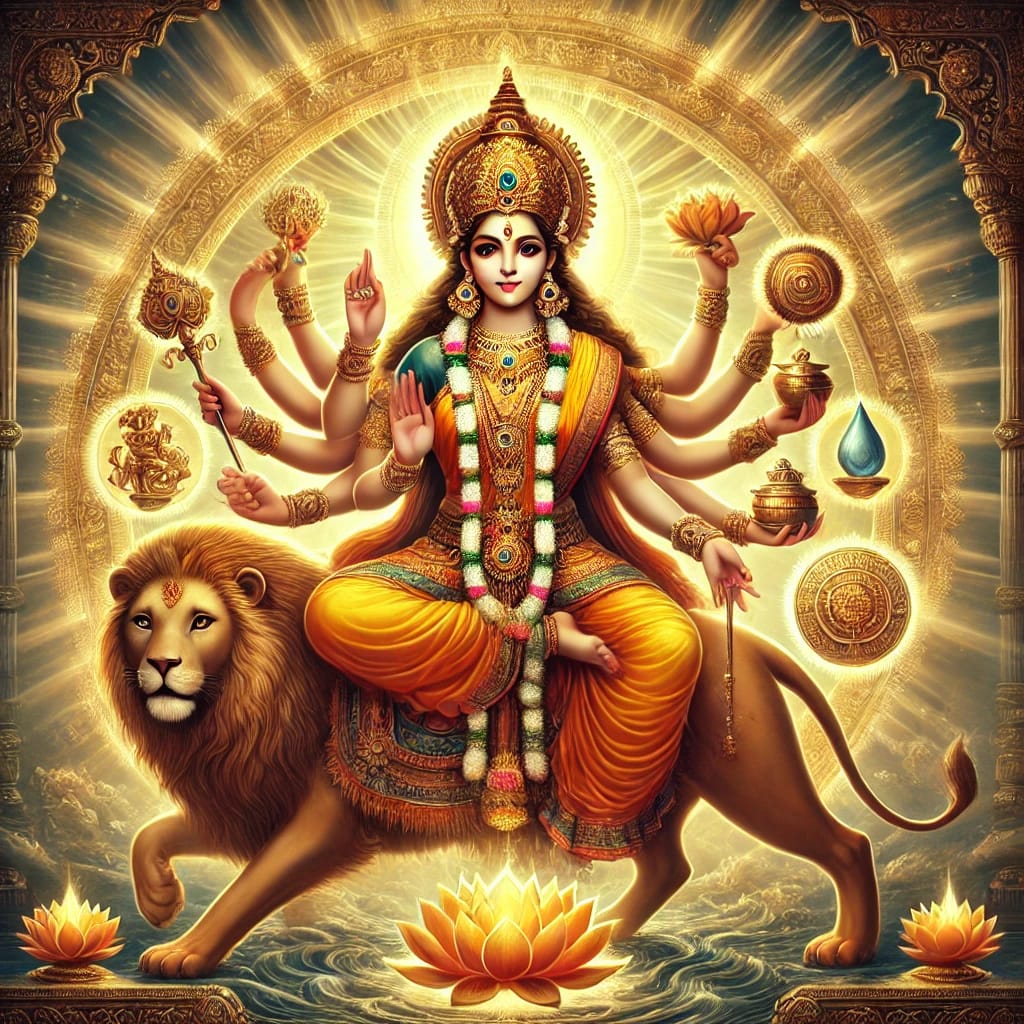
Form: The creator of the universe.
Symbolism: “Kushm” means little, “anda” means egg—she is believed to have created the universe from a cosmic egg with her radiant smile.
Appearance: She has eight arms and rides a lion. Each arm holds a different item, including a lotus, chakra, and bow.
Significance: She brings health, strength, and wealth to her devotees.
Color: Yellow
Rituals: Worship with pumpkin, malpua (Indian sweets), and yellow flowers. Meditate on health and prosperity, and offer water mixed with honey.
Prasad: Malpua, honey, and fruits.
5. Skandamata (Day 5)
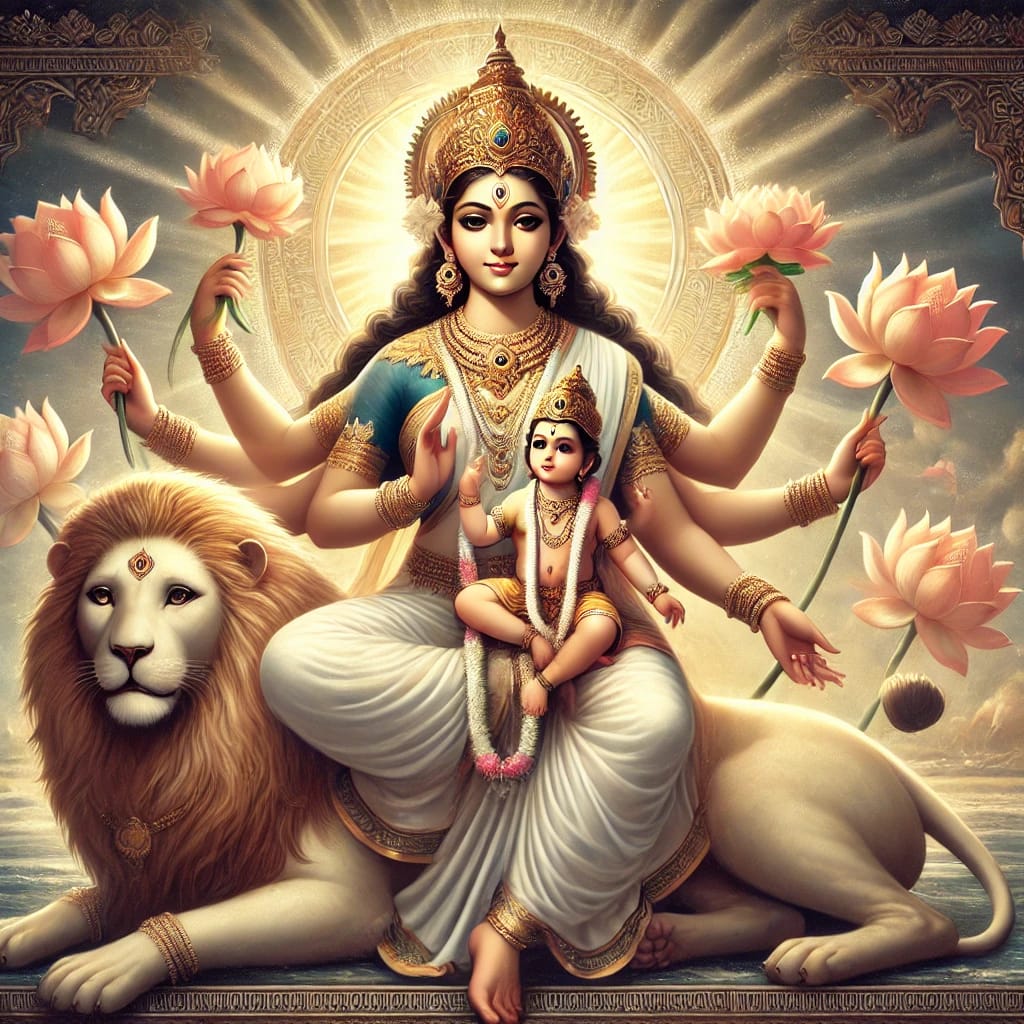
Form: Mother of Lord Kartikeya (Skanda).
Symbolism: She symbolizes motherhood and nurturing. She governs the Vishuddha chakra (throat chakra).
Appearance: She carries her son, Skanda, in her lap and rides a lion. She has four arms, two of which carry lotuses.
Significance: Worshipping her blesses devotees with wisdom and salvation.
Color: Green
Rituals: Offer green leaves, fruits, and flowers. Light a ghee lamp and pray for the well-being of children. Recite Skandamata stotra or mantra.
Prasad: Bananas and sweets.
6. Katyayani (Day 6)
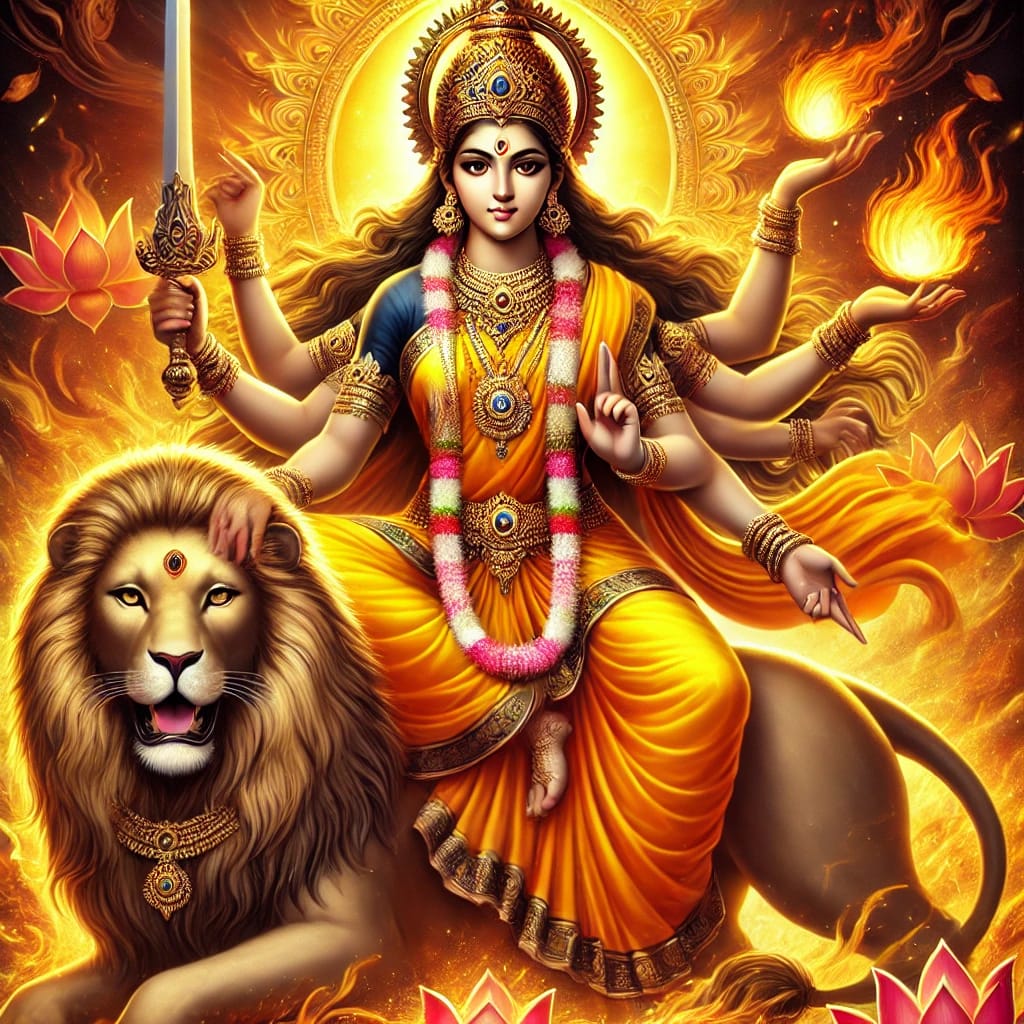
Form: The warrior goddess.
Symbolism: She is born from the anger of the gods and represents the fierce form of Durga. She rides a lion and is known for destroying evil forces.
Appearance: She has four arms, with one hand granting blessings and another in a protective pose, while the other two carry weapons.
Significance: She helps remove obstacles in life and blesses with strength and victory.
Color: Orange
Rituals: Offer red flowers, honey, and sweets. Pray for courage and strength to overcome obstacles. Focus on personal and spiritual growth.
Prasad: Honey, sweets, and fruits.
7. Kalaratri (Day 7)
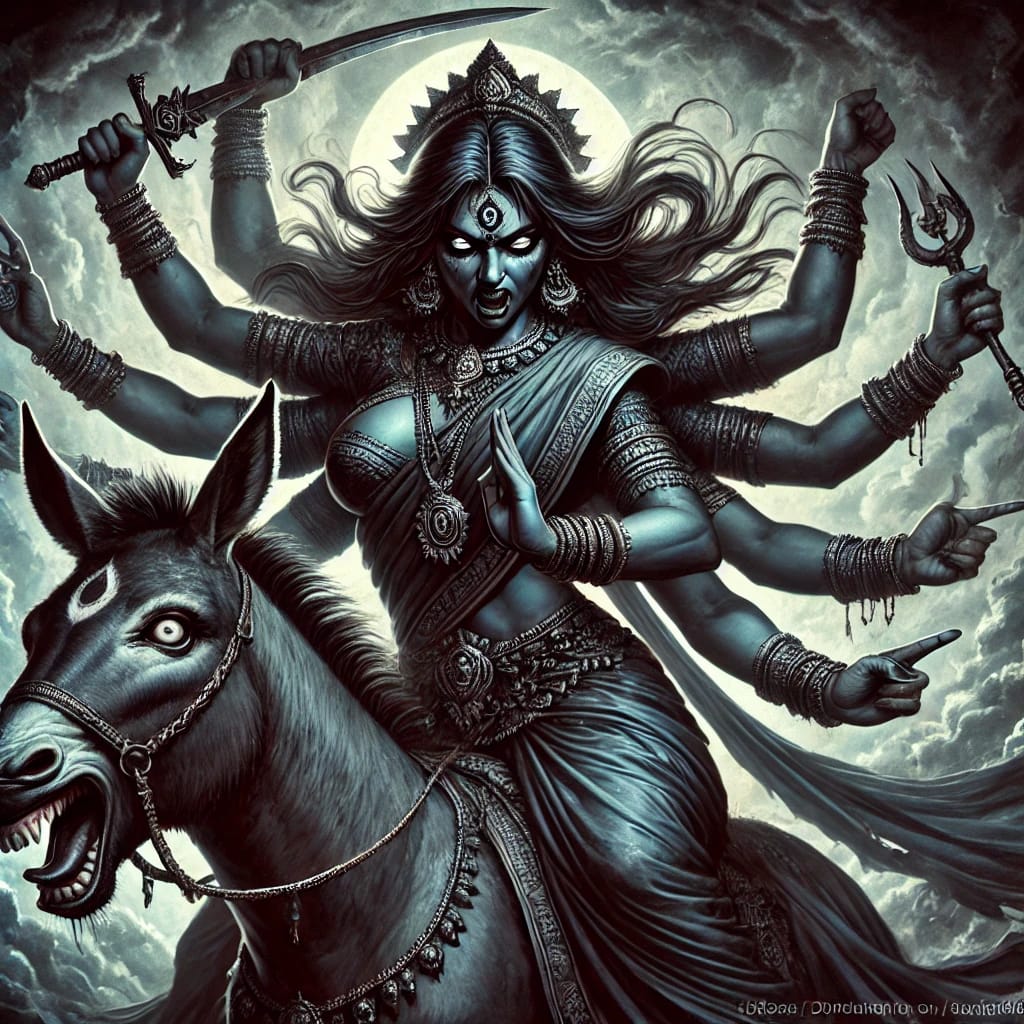
Form: The destroyer of darkness and ignorance.
Symbolism: She is the fiercest form of Durga, who destroys evil. She is associated with the Sahasrara chakra (crown chakra).
Appearance: She is dark-skinned, rides a donkey, has disheveled hair, and breathes fire. She carries a sword and a trident.
Significance: Worshipping her removes negative energies, evil, and fears.
Color: Grey
Rituals: Offer jaggery and light an oil lamp. Recite Kalaratri mantras to remove fears and negativity. Worship for protection against evil forces.
Prasad: Jaggery-based dishes.
8. Mahagauri (Day 8)

Form: Goddess of purity, peace, and serenity.
Symbolism: She is the form of Parvati after she performed severe penance to attain Lord Shiva. She governs the crown chakra and symbolizes purity.
Appearance: She is dressed in white and rides a bull, holding a trident and a drum.
Significance: Worshipping her purifies the heart and soul and brings peace and calmness.
Color: PinkRituals: Offer coconut, white flowers, and sweets made from milk. Focus on inner purity and spiritual peace. Chant Mahagauri stotra.
Prasad: Coconut-based sweets or dishes.
9. Siddhidatri (Day 9)

Form: Bestower of supernatural powers (siddhis).
Symbolism: She governs the Muladhara (root) chakra and is considered the one who grants all siddhis or mystical powers to her devotees.
Appearance: She sits on a lotus and has four arms, holding a mace, a discus, a lotus, and a conch.
Significance: Worshipping her brings fulfillment of desires and grants success and spiritual enlightenment.
Color: Purple
Rituals: Offer sesame seeds and flowers. Meditate on achieving spiritual goals and ask for the goddess’ blessings for wisdom and accomplishments.
Prasad: Til (sesame) or til-based dishes.These nine forms of Durga represent the cycle of creation, protection, destruction of evil, and eventual salvation, making Navratri a time for spiritual growth and divine blessings.
General Rituals Across NavratriKalash Sthapana (Ghatasthapana):
On the first day, establish a pot (kalash) symbolizing the goddess at the altar, filled with water, mango leaves, and a coconut on top.
Lighting a Lamp: A ghee lamp should be lit each day, symbolizing the eternal power and light of the goddess.
Chanting and Prayers: Recite Durga Saptashati or mantras like “Om Dum Durgaye Namah” every day.
Fasting: Many devotees fast for all nine days, consuming only satvik food (no onion, garlic, or grains in some traditions) to purify the body and mind.
Kanya Puja: On the 8th or 9th day, worship young girls (symbolizing the goddess) by offering them food, sweets, and gifts.
Maintaining a clean, dedicated space for the goddess, keeping a positive mindset, and offering pure devotion are the most important elements of worship during Navratri.
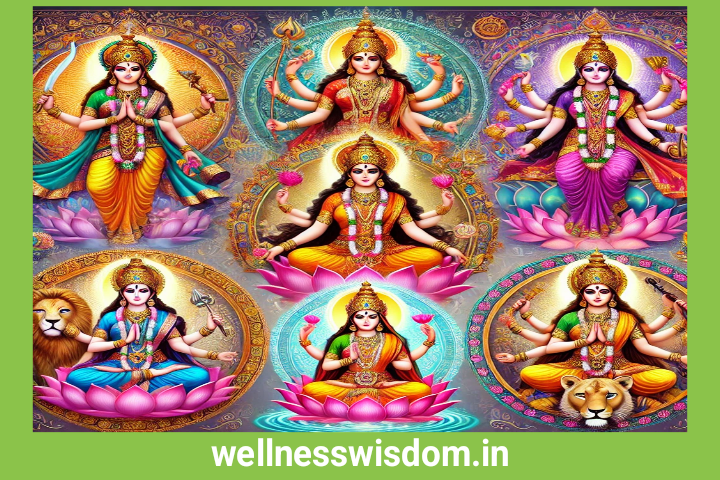
🌸Jay mata di🌸
Happy navratri🙏🙏
🌺Happy Navratri🌺
🌼Jay Mata di🌼🌻🪷
Jai Mata Di
Jai mata di 🙏🙏
Jay mata di
जय माता दी
माता रानी सभी का कल्याण करें l 🙏🙏
Hey Durgesh,
I just wanted to give you huge congratulations on launching your new website! It’s awesome to see your passion and knowledge come to life. Your first post about Navratri and the related goddesses is a fantastic start. I can’t wait to see what you do next.
Keep up the great work!
Best wishes 💫
Tq so much
Thanku so much
Thanku so much.